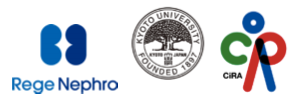Rege Nephro Announces Joint Research Agreement with CiRA, Kyoto University and AstraZeneca Research aims to produce kidney tissue from induced pluripotent stem cells

Rege Nephro Co., Ltd. (Head Office: Sakyo-ku, Kyoto, Representative Director: Toshihiro Ishikiriyama) announces a joint research agreement with Center for iPS Cell Research and Application, Kyoto University (Headquarters: Sakyo-ku, Kyoto, Director: Shinya Yamanaka, hereinafter “CiRA”) and AstraZeneca (Head Office: United Kingdom) to develop a method for producing renal tissues from human induced pluripotent stem (iPS) cell-derived renal progenitor cells1) and to analyze their developmental biology and physiological functions in-vivo.
In this joint research, Rege Nephro and CiRA aim to produce new renal progenitor cells and renal tissues for optimized in-vivo kidney transplantation in preclinical models2). The research will be conducted in close collaboration with AstraZeneca, which will perform omics profiling3), including transcriptomics4) and histological analysis of renal progenitor cells and new renal tissues produced.
Rege Nephro is a venture company established in September 2019 based on the research of Professor Kenji Osafune of Department of Cell Growth and Differentiation, CiRA, who also serves as a board member of Rege Nephro. After discovering the existence of renal progenitor cells for the first time in the world, Professor Osafune has succeeded in establishing a technology to efficiently produce renal progenitor cells from iPS cells.
Nearly 850 million people worldwide are living with chronic kidney disease (CKD) and in Japan the number of patients with CKD has reached about 13 million, 13% of the adult population. While there are treatments currently available that benefit patients with CKD, when the condition deteriorates, dialysis or kidney transplantation is required, and serious donor shortages exist. The number of patients needing dialysis is increasing year by year, and the medical expenses make CKD one of the most expensive chronic diseases worldwide (exceeding 1.5 trillion Japanese yen per year). Development of new therapeutics to stop disease progression, manage morbidity and mortality, and ultimately modify and even reverse the disease itself has become a social urgent need.
Professor Osafune has established a method of induction and differentiation from human iPS cells into two renal progenitor cells; nephron progenitor cells5) that make glomerulus and tubules, and ureteral buds6) that make collecting ducts. In addition, by combining renal progenitor cells made from these human iPS cells, he succeeded in producing kidney tissue with three-dimensional (but small: the size is about a few millimeters) structure in which a glomerulus, tubules and collecting ducts are connected.
Regenerative approaches for renal therapies have been a focus for AstraZeneca, which has established method for producing the kidney organoids for analyzing renal function in cells.
With the launch of this joint research, a strong international team has been formed to realize kidney regenerative medicine. While it will still take years for clinical application, being able to mass-produce and supply transplant kidneys in the future would get us closer to the ultimate goal of creating a world that does not require dialysis.
Rege Nephro, CiRA and AstraZeneca’s researchers will jointly participate in this project. Rege Nephro provides progenitor cells production technology which has been introduced by Kyoto University, and AstraZeneca provides most of the research funds.
Rege Nephro will promote their business under the mission of improving the quality of life (QOL) of the patients suffering from kidney diseases and contributing to society by concluding a joint research agreement with CiRA and AstraZeneca.
Note 1) Renal progenitor cell
Cells that are the basis of differentiation into the kidney include nephron progenitor cells that differentiate into glomeruli and renal tubules, ureteric buds that differentiate into collecting ducts, and interstitial progenitor cells.
Note 2) Preclinical model
Refers to the stage of research performed prior to human verification to evaluate effectiveness and safety.
Notes 3) Omics profiling
Refers to the field that analyzes the interaction and function of a large amount of biological information existing in the living body. The purpose is to characterize and quantify biomolecules that dynamically transform the structure and function of organisms.
Note 4) Transcriptomics
Refers to the field that comprehensively studies messenger RNA (mRNA) that exists in cells in the living body. Analyzing the amount of mRNA in cells, allows researchers to identify genes involved in phenotypic expression to quantitatively investigate their expression status.
Note 5) Nephron progenitor cells
Cells in the developing kidney that produce tissues called nephrons (glomeruli and tubules) that produce urine in the kidneys. There are separate cells that are the source of the collecting ducts, lower urinary system, which is the drainage channel for urine, and interstitial progenitor cells that fill the gaps in the kidney tissue.
Note 6) Ureteric bud
One of the precursor tissues of the kidney during the embryonic stage. It matures in vivo by repeatedly dividing into numerous branches and differentiates into the collecting ducts, the urinary excretory tract, and the lower urinary tract system in the future.
<Rege Nephro Overview>
Rege Nephro Co., Ltd.
Representative Director: Toshihiro Ishikiriyama
Address:
Med-Pharm Collaboration bldg. 409s, Kyoto University, 46-29 YoshidaShimoadachi-cho, Sakyo-ku, Kyoto, 606-8501 JAPAN
Business Description: Research and development, production and sales of renal disease treatment technology
Establishment: September 2019
URL: https://regenephro.co.jp
<CiRA Overview>
Center for iPS Cell Research and Application, Kyoto University
Director: Shinya Yamanaka
Address: 53 ShogoinKawahara-cho, Sakyo-ku, Kyoto, 606-8507 JAPAN
Department in charge: Osafune Laboratory, Center for iPS Cell Research and Application, Kyoto University
Established: April 2010
URL: https://www.kyoto-u.ac.jp/ja
<Inquiries regarding this matter>
Katsuhisa Yamaguchi
CFO, a member of Board of Directors
Rege Nephro Co., Ltd.
TEL: +81-75-744-6858
E-mail: info@regenephro.co.jp
Yoko Miyake
International Public Communications Office
Center for iPS Cell Research and Application (CiRA) Kyoto University
TEL: +81-75-366-7005
E-mail: media@cira.kyoto-u.ac.jp

